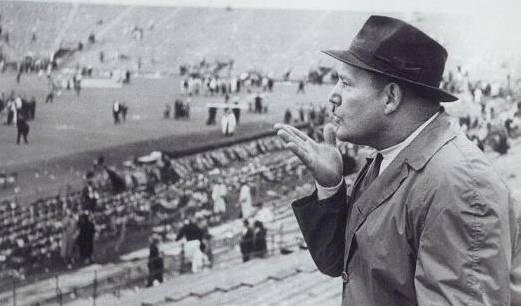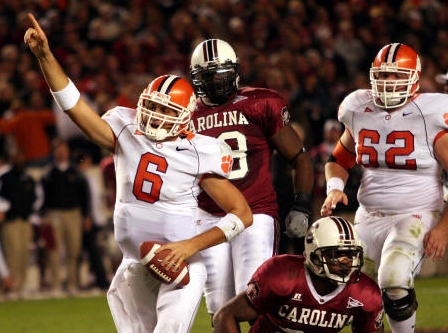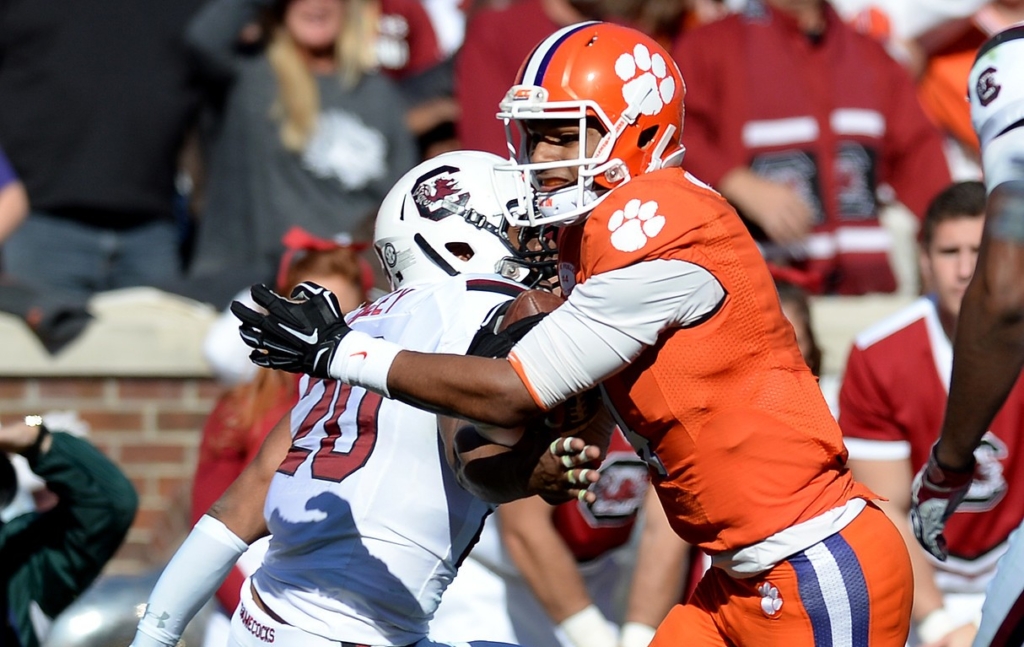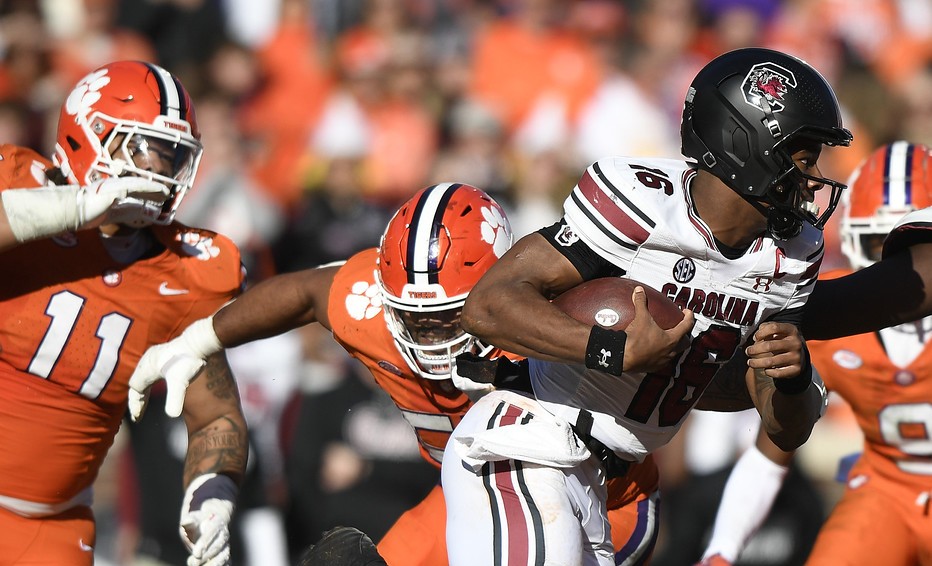Nothing gets me more fired up than the Clemson-South Carolina rivalry, especially the football game.
I was born and raised in South Carolina. I understand the hate between the two fanbases as well as anyone born in the Palmetto State.
The back and forth between the two is what makes it so much fun. I often come across threads on message boards, X and Facebook where the two sets of fans are at each other’s throats about who is the best and who is not.
What I love reading the most are some of the inaccurate statements both fans claim in the rivalry. So, as a self-proclaimed historian, and as someone who has followed this rivalry pretty much since I was seven years old, here are some facts for your next argument at the water cooler or on the message board threads.
Also, my stats are based off a historical point in the rivalry, and where consistency was maintained over a long period of time after that event took place.
For instance, since Dabo Swinney has been the head coach at Clemson, and that dates back to the 2008 season when he was the interim, the Tigers are 9-7 versus South Carolina. This includes Clemson’s seven-game win streak and the Gamecocks’ five-game win streak.
During this period, I am not writing anything other than about the two streaks I mentioned above. This period of time is one of the consistently competitive periods in the history of the rivalry from a win-loss standpoint.
My point is this, we can make stats fit any narrative we want, so it is fair to measure the data consistently based on historical events that surround the rivalry.
- South Carolina won the first game in the series, 12-6, in 1896. This is the only time the Gamecocks had the lead in the 121-year history of the series. That’s right, it was in 1896. Clemson went on to win the next four meetings.
- In 1900, the Tigers beat South Carolina 51-0, still the largest margin of victory by either side in the rivalry.
- In 1902, South Carolina fans were carrying around a poster with the image of a tiger with a gamecock standing on top of it, holding the tiger’s tail. Obviously, Clemson did not like this and asked the Gamecock students not to bring the image to the Friday Parade the next day. After South Carolina’s win, they did exactly what the Clemson Cadets asked them not to do. As a result, some 200 or so Clemson cadets stormed USC’s Horseshoe with rifles and bayonets, aiming to retrieve the sign. In response, about 50 Carolina students armed themselves with knives and pistols to defend the campus and sign. Luckly, local law enforcement, and officials from both schools, were able to defuse the situation. The near civil war, if you will, was too much for both schools and the game was cancelled for the next six years.
- When the series resumed in 1909, Clemson won 6-0, its first of nine victories against the Gamecocks over the next 11 years (9-1-1). The two rivals met every year for 111 consecutive football seasons (1909-2019), surviving two World Wars, the Southern Conference, the assignation of President John Kennedy, the Vietnam War and the Cold War. However, in 2020, the game was canceled due to the SEC’s COVID concerns. Coincidentally, the rivalry survived the Spanish Flu pandemic of 1918.
- From 1934-’40, Clemson won seven straight games over the Gamecocks, which is still tied (Clemson 2014-’19, 2021) as the longest win streak by either school in the series. It is no coincidence that the Tigers dominated the series at the time. In 1934, Clemson began the nation’s first booster club organization to help fund athletic scholarships. The organization was named IPTAY (I Pay Ten A Year).
- South Carolina had its best run in the series from 1946-’54. In those nine years, the Gamecocks produced a 7-1-1 record against the Tigers. Carolina won four straight games from 1951-’54.
- In 1952, the rivalry was almost interrupted thanks to the Southern Conference. The league punished Clemson and Maryland for accepting bowl bids following the 1951 season, which was against league rules. The conference ordered South Carolina, and other member schools, not to play Clemson or Maryland in 1952 as their punishment. However, upon the request of both schools, the South Carolina General Assembly passed a resolution on February 27, 1952, ordering the game to be played. The Gamecocks won the contest 6–0. The SoCon reacted to the game by attempting to suspend Clemson, leading seven member schools, including Clemson and USC, to leave the league and form the Atlantic Coast Conference in May of 1953.
- From 1896-1959, the Clemson-Carolina game was known as “Big Thursday” in South Carolina. The game was unofficially a state holiday, as businesses and schools closed on the third Thursday of every October so the game could be played in front of a big crowd during the State Fair in Columbia. However, after years of saying it was unfair to have to travel to Columbia every year, Clemson finally got the game moved to a home-and-home series starting in 1960. The 1959 game marked the last Big Thursday, a game Clemson won 27-0. The Tigers owned a 33-21-3 record in the 57 Big Thursday games that were played. After the game, Clemson head coach Frank Howard was photographed by the State (Columbia) Newspaper looking out over Carolina Stadium and blowing a kiss, symbolizing Clemson finally kissing Big Thursday goodbye. This image is considered one of the more iconic images in the history of the rivalry.

- In 1969, longtime Clemson coach Frank Howard coached in his final Clemson-Carolina game. The Gamecocks won 27-13 in Columbia. Howard finished his career against USC with a 14-15-1 record. He is still the only Clemson coach (minimum four games) to have a losing record to the Gamecocks.
- In 1975, South Carolina All-American quarterback Jeff Grantz throw a touchdowns pass with 19 seconds to play, as the Gamecocks hand the Tigers their worst loss in the series, 56-20. However, after the game, Clemson’s players and coaches vow to never let themselves be embarrassed by the Gamecocks again. Starting in 1976, Clemson owns a 32-15-1 (.677) record over the Gamecocks.
- Clemson’s Jerry Butler made arguably the greatest play in the rivalry’s history when he made a leaping, twisting 20-yard TD catch of a Steve Fuller pass with 49 seconds to play to beat the Gamecocks, 31-27. Since 1977, the Tigers are 18-6 against South Carolina at Williams-Brice Stadium in Columbia.
- Willie Underwood intercepted two passes, returning one for a TD and setting up another, as Clemson beat No. 14 South Carolina 27-6 in 1980. The win saved Danny Ford’s job and propelled the Tigers to the 1981 National Championship. The 1980 South Carolina game was also the first time the Tigers wore their famous orange pants, as they came down the hill in Death Valley in all orange for the first time. Clemson won the next three games in the series and dominated the 1980’s with a 7-2-1 record.
- Clemson’s David Treadwell kicked a second-half field goal to force a 21-21 tie in Death Valley in 1986. It is the last time the rivalry game ended in a tie.
- Clemson beat the Gamecocks 63-17 in 2003 in Columbia. The Tigers’ 63 points are still the most points scored by either team in the rivalry.
- Clemson defeated a top-20 South Carolina team on the road for the first time in a 13-9 victory. Charlie Whitehurst beat the Gamecocks for the fourth straight year, the only time in the history of the series a starting quarterback had a perfect 4-0 record in the series.

- In 2009, the Gamecocks stunned No. 15 Clemson 34-17 in Columbia. It marked the first of five straight wins for South Carolina in the series, its longest win streak in the rivalry game.
- Playing with a torn ACL, Deshaun Watson threw for two scores and ran for two others in Clemson’s 35-17 win over South Carolina, ending the Gamecocks five-game winning streak in the series. Artavis Scott had seven catches for 185 yards and two scores, the most receiving yards by a Clemson player against South Carolina and the most ever by a Tiger in Death Valley. The win marked the first of seven straight victories for Clemson in the series, tying the program’s mark for consecutive wins in the series (1934-’40).
- South Carolina ends Clemson’s 40-game home winning streak, the nation’s longest at the time, as well as its seven-game losing streak to the Tigers, with a dramatic 31-30 victory in Death Valley.
- South Carolina currently owns bragging rights, thanks to another stunning victory over Clemson in Death Valley last season. The Gamecocks rallied to beat the Tigers, 17-14, behind LaNorris Sellars’ two rushing touchdowns.
- Clemson leads the series overall with a 73-44-4 (.619) mark.

